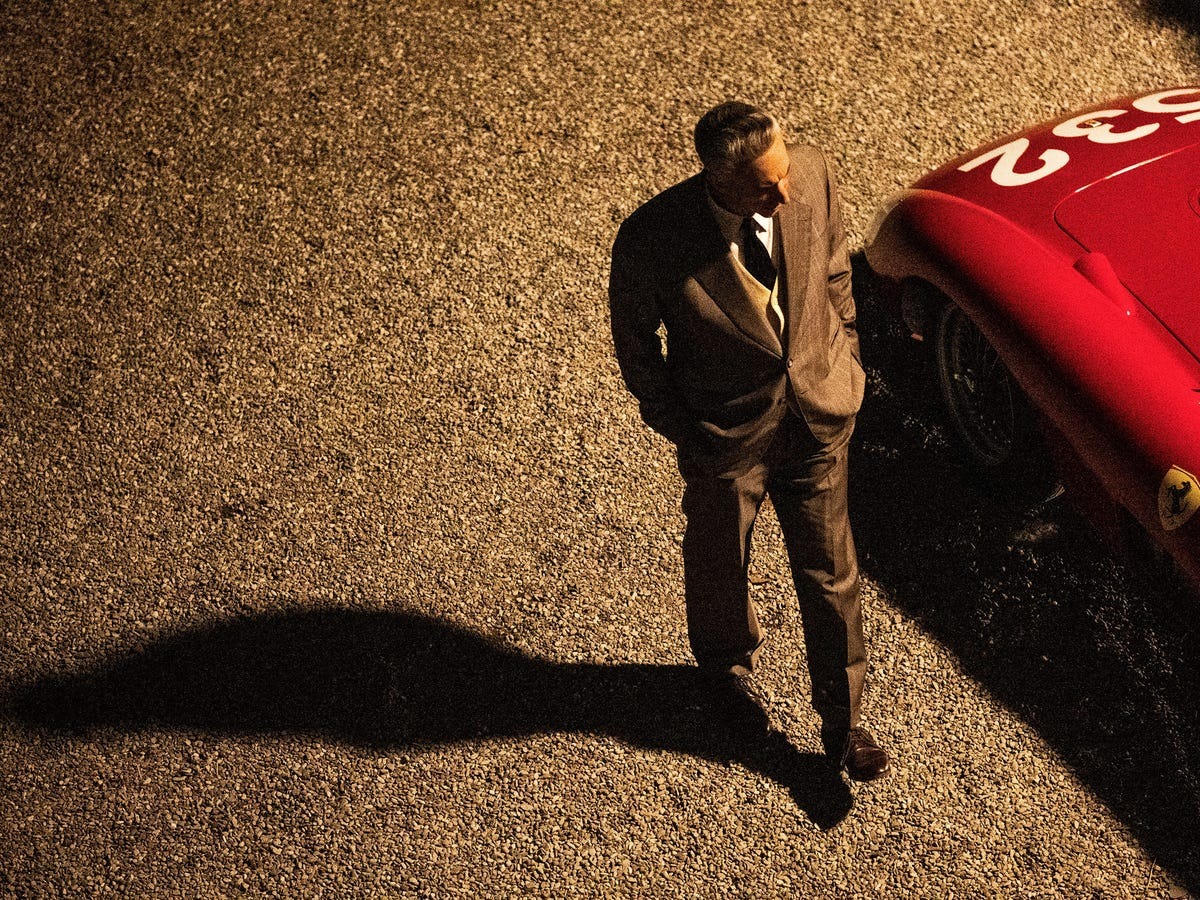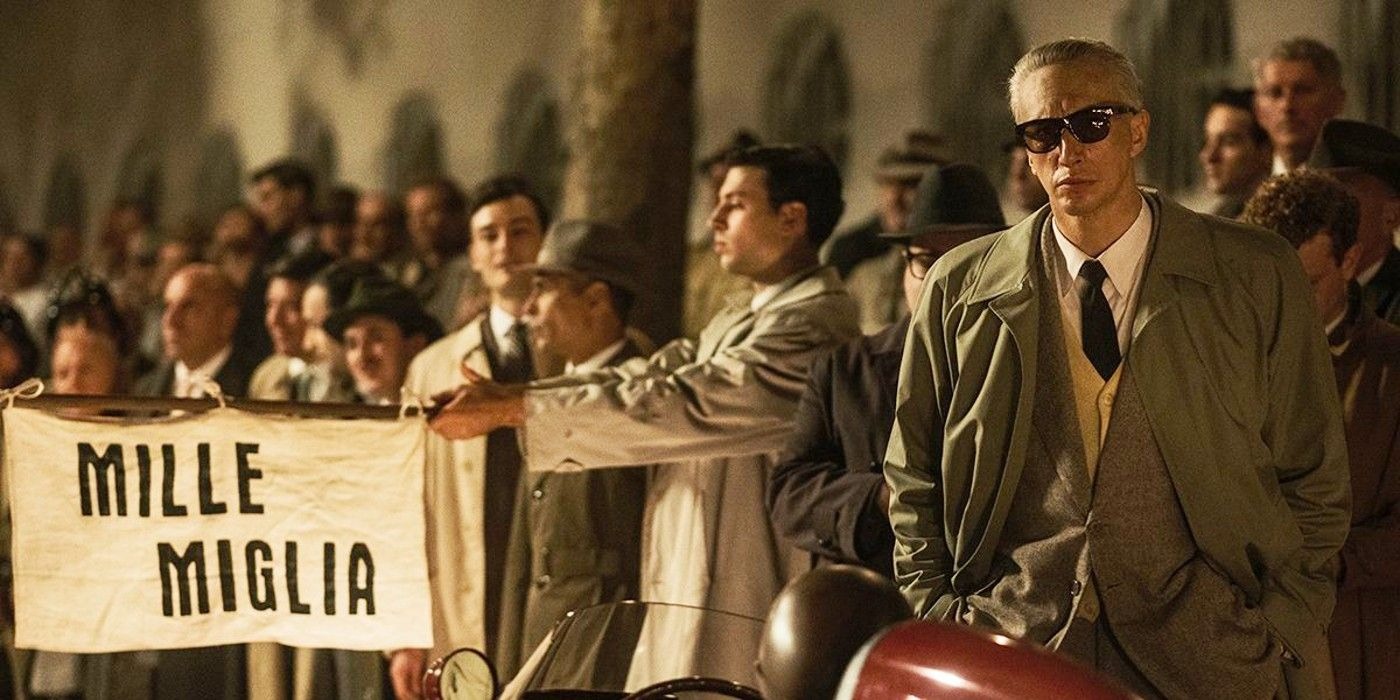For those who aren’t experts in racing history and may not be familiar with the tragic events of the 1957 Mille Miglia, the climax of Michael Mann’s film Ferrari could be quite shocking. This shock comes not just from the graphic devastation displayed on screen but also from the subtle ways the film has played with our expectations up to this moment.
Throughout the movie, Mann has set up the upcoming race—“A thousand miles across bad roads with sheep and dogs — anything can happen,” as Penélope Cruz’s character, Laura Ferrari, memorably describes it—as a pivotal moment for Enzo Ferrari (played by Adam Driver).

His business is on the brink of collapse, burdened by immense debt and a series of failures. “Win the Mille Miglia, Enzo. Attract outside financing. Or you are out of business,” warns his lawyer and advisor, Giacomo Cuoghi (Giuseppe Bonifati). Given that we know the Ferrari brand finally survived, there’s a sense of confidence that Enzo’s team will triumph in the race.
The film has also established young Spanish racer Alfonso de Portago (Gabriel Leone) as a promising talent ready to turn Ferrari’s fortunes around. Enzo’s initial rejection of de Portago’s requests to join the team subconsciously reinforces our belief that the young racer will succeed. His earlier struggles in another race, which anger Enzo, set up a story arc of redemption.
This formula is typical in racing films—de Portago represents the classic underdog. Thus, when his car veers off the road at Guidizzolo, crashing into a group of spectators and resulting in many fatalities as well as the horrifying scene of the once-promising racer being severed in half, viewers experience shock on multiple levels.
The Impact of the Guidizzolo Crash
The Guidizzolo crash is haunting and devastating. The Mille Miglia race, already notorious for its dangers, was finally canceled after the tragic events of 1957. Mann does not shy away from depicting the full extent of this calamity.
During my interview with him about the film, he described the race cars as “savage,” highlighting their lethal potential: “They can kill you in a heartbeat. They have more power than you can handle. They have more power than the brakes can handle. One tiny thing goes wrong, and the result is catastrophic.”
To accurately recreate this pivotal sequence, Mann and his team conducted extensive research, examining perhaps the most infamous racing disaster on record—the 1955 Le Mans crash, which claimed 83 lives, including that of driver Pierre Levegh.
The footage from the BBC of that incident is unsettling, as it takes time to recognize that these are actual people being affected by Levegh’s out-of-control vehicle. In Ferrari, Mann and his crew present a variation of this disaster, slowing down the sequence to allow viewers to witness the horrifying consequences of human lives being destroyed.
Editor Pietro Scalia recalls that it was crucial for Mann that this devastation occur in one continuous shot without cuts, resulting in a visceral and deeply unsettling experience, something rarely seen in cinematic car crashes. After witnessing this, viewers may reconsider getting into a car.
While researching the incident and its real-life location, Mann met an elderly man who revealed that his brother was among the victims at Guidizzolo. This encounter prompted Mann to incorporate a scene featuring this family into the film, further humanizing the tragedy.
“We need the audience to understand,” cinematographer Erik Messerschmidt recalls the director emphasizing. Mann aims for viewers to grasp the brutal nature of this sport and, perhaps, the heavy toll of Enzo’s relentless ambition and his insistence that racers push their limits—urging them to “brake later,” as he puts it.
Enzo’s Obsession with Victory
Ferrari does not portray Enzo as a villain, but his obsession with winning has dire consequences, possibly even leading to deaths. Just before the Guidizzolo tragedy, it becomes evident that Ferrari’s drivers are on a path to guaranteed victory at the Mille Miglia. Their main competitor, Maserati, has withdrawn due to mechanical failures and crashes.
De Portago triumphs over his French opponent Jean Behra (Derek Hill) after following Enzo’s advice to push through when Behra tries to force him off the road. Yet, eager to prove himself further, de Portago declines the pit crew’s offer to change his tires, indicating he might be taking Enzo’s instructions a bit too literally. (“When you get into one of my cars—and no one is forcing you to enter—you get in to win.”)
At this moment, Ferrari’s drivers are effectively competing against one another, a scenario Enzo encourages as he sends them out. A sensible approach would be to slow down and play it safe, but as Enzo earlier noted, they aren’t sportsmen; they are racers. His engineers suggest he should instruct the drivers to maintain their positions now that victory seems certain.
Enzo’s response? “They’ll wipe out or they won’t! My factory is built on racing. They are racers.” For these individuals, racing is not just a sport but a way of life. They accept that death can occur at any moment. A poignant scene in the film shows the drivers writing letters to their loved ones the night before the race, intended for delivery in case of their deaths.
Has Enzo’s overwhelming desire for victory led to this tragedy? He grapples with this question himself. Earlier in the film, he recalls that 24 years ago, after a disastrous crash that claimed the lives of his friends Baconin Borzacchini and Giuseppe Campari “in the metal I made,” he vowed not to let emotions cloud his racing judgment.
“I knew then that it was ‘Enzo build a wall’… or Enzo go do something else.” At the crash site at Guidizzolo, we witness the heartbreaking outcomes of this mindset. The tension on Driver’s face as he wanders through the scene at night reveals a man deeply tormented.
Enzo and Laura’s Final Confrontation
One might expect Enzo to learn a lesson from this tragedy, to experience some climactic self-awareness leading to emotional resolution. Yet the film offers little indication that he does. He may be cleared of responsibility for the Guidizzolo crash, but that doesn’t lessen the horror of the incident, nor does it spiritually cleanse Enzo.

We are left grappling with these conflicting ideas: he is a brilliant racing mogul, a creator of stunning machines, yet those same machines are capable of taking lives, especially when he urges racers to push their limits.
His marriage to Laura will persist even as Lina and Piero move to Modena to live with him. He has some affection for Laura, but resentment simmers beneath the surface—she feels the same. At one point, Enzo states plainly, “Nothing is resolved.” But life continues.
A glimmer of hope appears in the film’s final scene. Enzo arrives at the cemetery for his daily visit to Dino’s grave and finds young Piero waiting for him. Despite the horrors they have just endured, the boy seems unaware of the gravity of the situation; he even asks if Enzo finally got de Portago’s autograph.
Enzo’s life has always revolved around racing; that has been his way of coping. But now, with Piero’s presence, it seems he might finally have family. “Come, I’ll introduce you to your brother,” Enzo says. “I wish you could have known him. He would have taken you with him everywhere.”
According to Mann, these words evoke Enzo’s own youth. “The origins of this line are that Enzo himself went everywhere with his older brother,” the director reveals. “They were very, very close.” (Enzo’s brother also passed away young, during World War I.) This moment raises the question of whether Laura’s request has inadvertently prompted a change in Enzo.
By denying Piero the Ferrari name, she may have pushed Enzo to become a more engaged father, inspiring him to include the boy in ways he had not previously. “The way I wanted it to work is that he totally acknowledges Piero as his son in ways he hadn’t before,” Mann explains.
Enzo has never truly allowed himself to be vulnerable until this point. When he visited Dino’s grave, he did so in solitude. Now, he’s inviting someone else into his life. This change could symbolize a way to ensure that both Dino’s memory and the Ferrari name will live on. His worlds may remain unreconciled and unresolved, but perhaps they can now coexist.
You can stream Ferrari on Amazon Prime.



